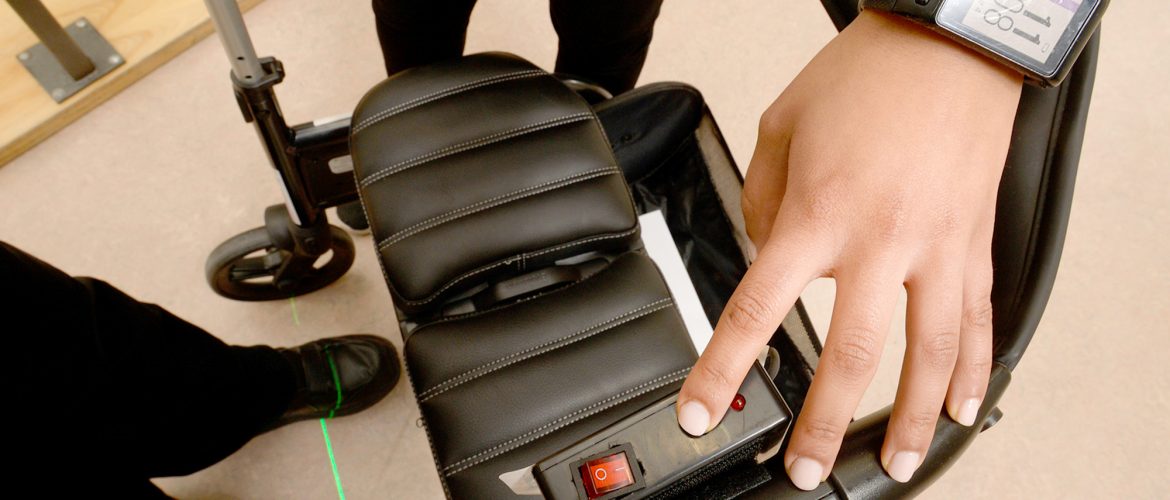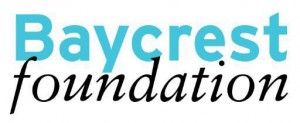Collaboration. It’s a word that gets thrown around all the time in industries ranging from music to education. However, bringing inter-professional minds together is important to other fields too – especially healthcare. Take the Laser Walk, an innovation receiving support through CABHI’s Spark program. The still-in-development project is the joint brainchild of physiotherapists, biomedical engineers and occupational therapists that work in a uniquely collaborative space.
First: what is Laser Walk
Laser Walk came about the way many innovations in healthcare do: to fill a gap. A physiotherapist at Toronto’s Assistive Technology Clinic was working with a patient experiencing a hallmark feature in Parkinson’s Disease: freezing of gait (also known simply as freezing). Freezing is exactly what it sounds like – the inability to move. A person dealing with freezing of gait might have trouble taking a step or getting up from a chair – in other words, something that is crucial to maintaining independence. According to the National Parkinson’s Foundation, about 38 percent of people living with Parkinson’s fall each year and freezing puts them at an even higher risk of doing so.
With all this in mind, the physiotherapist started looking into techniques to help with freezing. She came across the idea of visual cues (such as a laser) as a means to ease freezing of gait and motivate the patient to take larger steps. However, she couldn’t find an appropriate device out there that was a fit for her patient. Enter Vepeson Wijeya.
“I’m a biomedical engineer and so she asked me to sort of integrate technology with the patient’s current walker – to put a laser on it – so that she could mitigate his freezing gait,” explains Vepeson. “And so, what I initially came up with was a very rough laser with a camera battery added onto a rollator walker. We tried it and it worked pretty well.”

Meet the team. From left to right: Vepeson Wijeya, Pearl Gryfe and Karen Hall
Unique setup
The Assistive Technology Clinic has a unique setup: tech professionals like Vepeson are embedded in the team and collaborate directly with healthcare providers such as nurses, physicians and occupational therapists.
“Our clinic is a true integration of medicine, rehabilitation and technology – those are our three core programs,” shares Karen Hall, an occupational therapist and the clinical manager at ATC’s Baycrest site.
The laser was initially created with their own patients in mind. However, the team quickly realized its potential to help thousands of people outside of their clinic walls.
“It was just a prototype and it was originally meant as a tool to incorporate into our treatment plans,” shares Pearl Gryfe, director of ATC. “But then we decided this could be something more useful because the patients were asking, ‘Can I take this home?’”

Laser Walk technology mounted on a walker
Collaboration with CABHI
The team has been working on a prototype since late 2015. “It was a very rough prototype at that point – it was something that we could only use in-clinic and not actually use with the patients outside,” admits Vepeson.
The group learned about the Baycrest-led Centre for Aging + Brain Health Innovation (CABHI) and applied for the Spark program, which provides up to $50,000 to innovative grassroots ideas that can help improve quality of life for older adults.
“Having the Spark [financial support] has allowed us to account some time for Vepeson to actually work on this – that takes some time,” says Karen.
Now that ATC secured the financial support, Pearl says they’ve really been able to ramp up development on the Laser Walk. But CABHI’s involvement doesn’t end with the financial support itself. The team behind Laser Walk meets with a project manager from the centre monthly to talk about their progress and brainstorm solutions for any roadblocks.
They also get to be a part of a network of CABHI innovators, which includes dozens of organizations and inventors from across the globe. Pearl points to a CABHI-hosted Innovation Showcase earlier this year that ATC got to be a part of and demonstrate Laser Walk. “It’s interesting: that innovation showcase generated a lot of questions and calls to us to find out how they can get this device.”
Today and tomorrow
The Laser Walk has come a long way from its early prototype. The device, roughly the size of a pill bottle, can now fit onto most four-point canes and walkers and turn 360 degrees. It’s also rechargeable just like a cellphone and boasts 16 hours of continuous use. According to Vepeson, the team went with a green laser light because it’s better for outdoor use as the sun doesn’t absorb it.
In fact, making sure the device could be used outside of the clinic (such as in a patient’s home or out in the community) was crucial as most falls happen in environments patients know well, such as their homes. It was also important that the laser fit on the user’s existing mobility device to increase compliance and their comfort level.
ATC has already trialled the device with approximately 30 people and is collecting standardized outcomes for some of those. However, Pearl says the informal feedback from patients is the most valuable, as it’s helping the team refine the technology and find new purposes for it.
“One patient of mine just said, ‘You know, this would be good even just to go to the bathroom in the middle of the night,” Pearl laughs, adding later: “There’s lots of applications that we didn’t even think about. We didn’t think it would keep people out of wheelchairs; we thought it was just a visual cue. We didn’t know that people would use it at night to guide them – we didn’t know any of this.”
Today, the team sees a role for the Laser Walk not only for seniors living with Parkinson’s, but for those experiencing a wide range of conditions, including Multiple Sclerosis, stroke and even dementia. “It doesn’t take a lot of motor planning per se, not a lot of cognitive power,” says Pearl. “And yet, it keeps people out of wheelchairs. It keeps people from falling.”
They still have more work ahead of them, including finding a better way to mount the wires and doing more testing of the Laser Walk outside of the clinic. But there’s no question this project has come a long way thanks to the collaboration of multiple groups ranging from ATC’s team to CABHI and patients themselves.
“We’re actually very grateful for this CABHI program,” says Pearl. “I think we have a lot of opportunities here – not just for this project, but for many more in the future. Our patients always come up with things and so do our clinicians and technical staff. If we have this opportunity and this resource – that’s great for Canadian innovation.”
Learn more about the Spark program.


